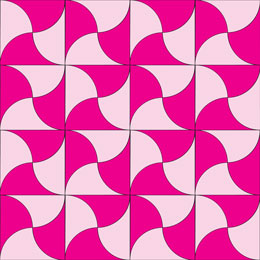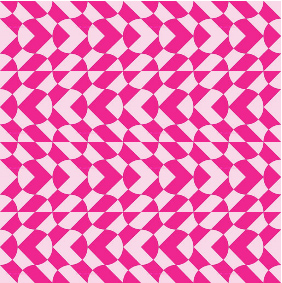Pointed Ovals
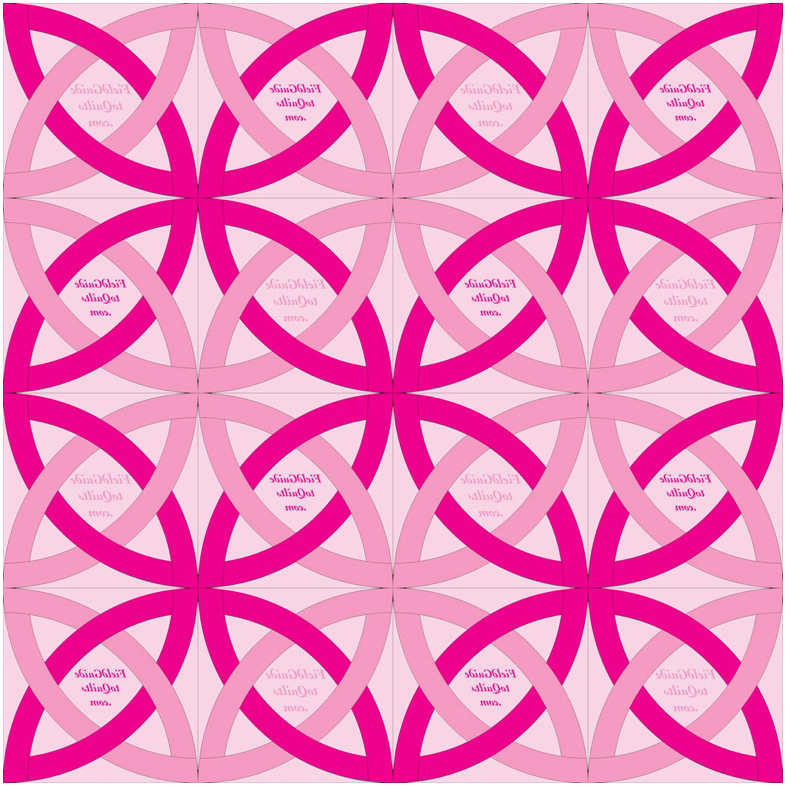 Pointed Ovals Pointed Ovals
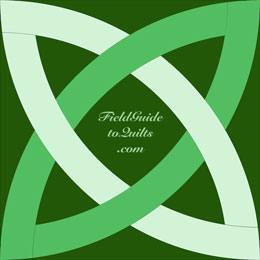 Pointed Ovals Kansas City Star, 1955 Pointed Ovals Kansas City Star, 1955 Love's Chain
Love's Chain
Pointed Ovals was a latecomer to the Kansas City Star's library of quilt blocks; it was published in 1955 and credited to a reader from Oklahoma. Her example, the Star said, was in orchid, yellow, and white.
Brackman's Encyclopedia of Pieced Quilt Patterns cites Nancy Cabot for the name Love's Chain.
|
Queen's Pride (nine-patch)
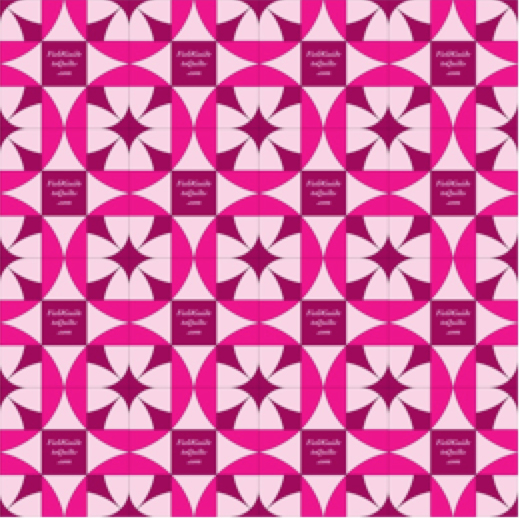 Queen's Pride 9-patch Queen's Pride 9-patch
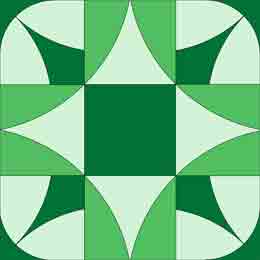 Queen's Pride Queen's PrideNine-patch Wheeler, 1934 An unknown designer at Old Chelsea Station Needlecraft Service produced this block back in 1934. An unknown designer at Old Chelsea Station Needlecraft Service produced this block back in 1934.
It was credited to Laura Wheeler — a pseudonym, as was the name Alice Brooks, whose designs also came from Old Chelsea Station.
Almost all of the OCS blocks appeared in the 1930s, when Art Deco reached the height of its popularity, and many of their blocks feature curves — a welcome challenge, no doubt, for experienced quilters.
Queen's Pride (four-patch)
 Queen's Pride Queen's Pride
Four-patch
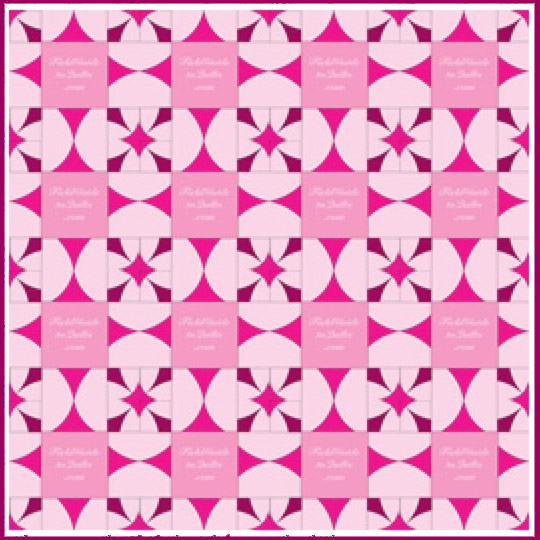 Queen's Pride 4-patch
Queen's Pride 4-patch |
Chimney Swallow(s)
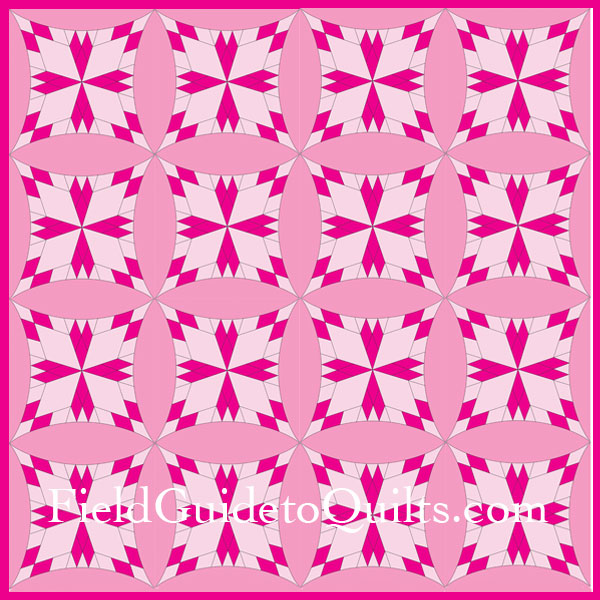 Chimney Swallows (LAC) Chimney Swallows (LAC)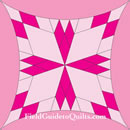 Chimney SwallowsLadies Art Company #355, 1897 Chimney SwallowsLadies Art Company #355, 1897 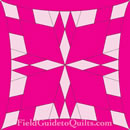 Chimney Swallow Stone, 1906 Chimney Swallow Stone, 1906
They came from Clara Stone, the Ladies Art Company, Ruth Finley, Nancy Cabot, Laura Wheeler, and Carrie Hall, who published two variations in 1935.

The oldest, as usual, was the Ladies Art Company block, published as #355 in the 1897 catalog.
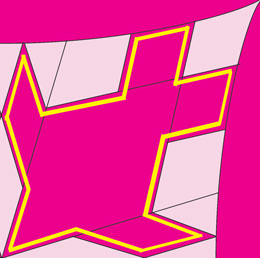
The swallow
in the upper
right corner.
|
Clara Stone's variation came along nine years later in her 1906 booklet Practical Needlework.
Its two colors create a silhouette of four swallows with their beaks touching at the block's center. In Stone's stark dark and light colors, it's not all that easy to see, but they're there.
Oddly enough, the block was called Chimney Swallow (singular).
Twenty-four years after Stone published her variations, Carrie Hall published two more in Romance of the Patchwork Quilt in America.
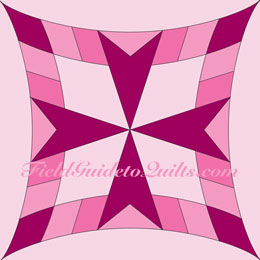 Chimney Swallows Hall, 1935 Chimney Swallows Hall, 1935
|
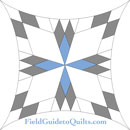 Chimney Swallows
Hall, 1935 Chimney Swallows
Hall, 1935
|
 What's the difference between all these blocks? What's the difference between all these blocks?
Look at the outer curves. The curve is more dramatic on the LAC's.
Hall's includes the multi-piece curves of a Double Wedding Ring. Hall also stitched up a block similar to the LAC's, using white, gray, and blue. We added blue to the background for the whole-quilt mockup.
Hall didn't design her blocks, to our knowledge; she collected them on her back-road travels through rural America.
Very likely it was a mathematically minded farm wife who came up with this sophisticated design.
Rural quilters were resourceful. They often measured their blocks by folding fabric squares in halves and thirds and
sometimes in complex configurations that were just awesome.
|
Friendship Knot (Finley)
   
   
   
   
Friendship Knot (Finley)
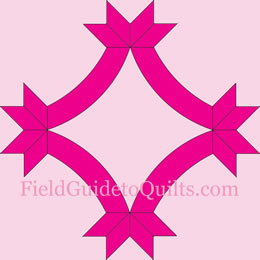 Friendship Knot Finley, 1929 Friendship Knot Finley, 1929
Ruth Finley, who collected quilt-block designs for her 1929 book Old Patchwork Quilts, traced this design from a block she found in a box of 1860s-era "trash" in the basement of an old church.
There were also fundraising notes from the church women's group: They earned $2.00 for quilting a quilt 2-1/2 x 2-1/2 yards square. (Quilting is sewing a quilt's back, stuffing, and top together with decorative stitching.)
Finley estimated that such a quilt would have 1,000 yards of fancy stitching, done at 5 yards per hour. The means the ladies earned one penny an hour. In 2019, that would be about 17 cents an hour.
The pay hasn't improved much. Just check out the selling prices for quilts on eBay.
Per Beyer, Finley's block is based on a 22x22 grid. |
|
Cleopatra's Fan
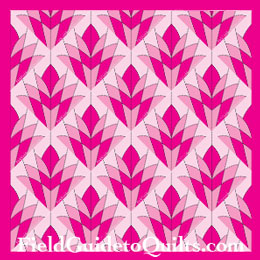 Cleopatra's Fan Cleopatra's Fan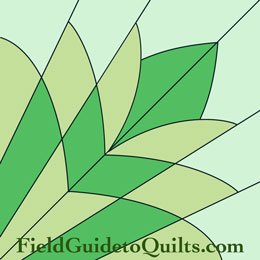 Cleopatra's Fan Cleopatra's Fan This is one of the quilt blocks published by Old Chelsea Needlecraft Co. under the name Laura Wheeler, whose true identity remains a secret to this day. It was published in the Cincinnati Enquirer on October 5, 1934.
This is one of the quilt blocks published by Old Chelsea Needlecraft Co. under the name Laura Wheeler, whose true identity remains a secret to this day. It was published in the Cincinnati Enquirer on October 5, 1934.
The instructions recommended setting the blocks on point, as in our pink-bordered example. The other example shows four blocks, or the equivalent of a full circle. We think of it as Cleopatra's Circle..
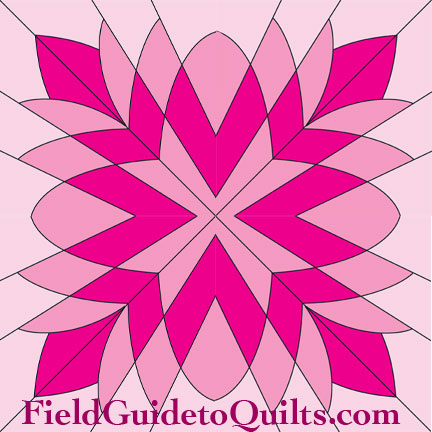 Cleopatra's Circle (one possible setting) Cleopatra's Circle (one possible setting)
|
|
Letha's Electric Fan
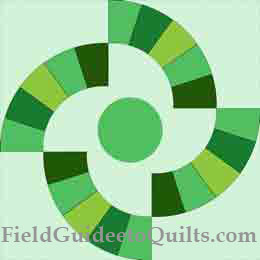 Letha's Electric Fan Letha's Electric Fan KCS, 1938 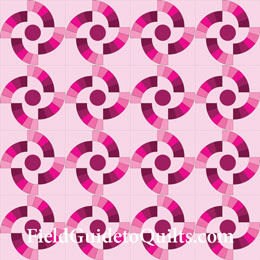 Letha's Electric Fan Letha's Electric Fan
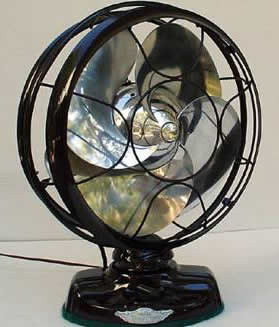 |
Silver Swan Electric Fan,
ca. 1935
Photo courtesy of Emerson Air Comfort Products |
This block was published in the Kansas City Star in 1938.
That was four years after the Emerson Co. came out with a fan called the Silver Swan. It was not only a top seller but became "a design icon," one journalist wrote.*
The block layout is made of four rectangular miniblocks, each with a quarter-block fan, placed on a 12 x 12 grid with a square containing a circle in the middle.
*John Seabrook, "James Dyson: "Annals of Invention: How to Make It," The New Yorker, 9/20/2010.
|
|
Winding Ways
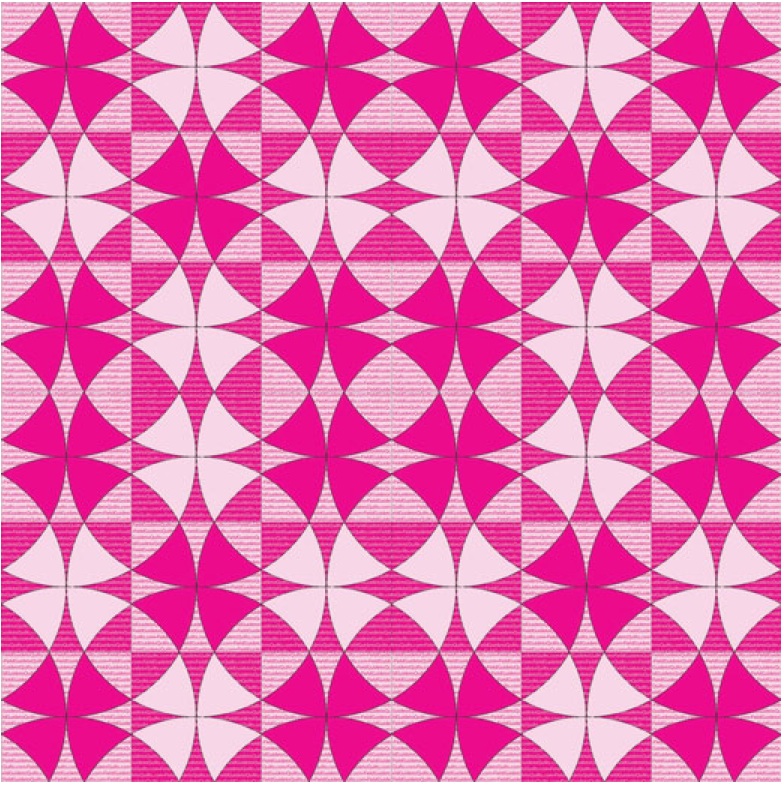 Winding Ways Winding Ways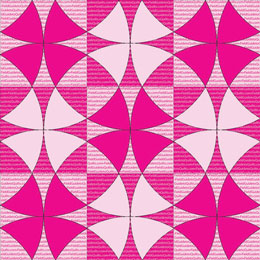 Winding Ways
LAC, #463 Winding Ways
LAC, #463
1922
Rob Peter to Pay Paul/Robbing Peter to Pay Paul/Peter & Paul/Nashville/Ways of the World/Wheel of Mystery/Wheel of Mysterie/Wondrous Ways/Four Leaf Clover/Yours for Luck
This beautiful and very popular block got its name in the usual way — the Ladies Art Company published it (#463, 1922).
It was republished under a flurry of names in the 1930s, and then once again in 1959, in the Kansas City Star, as Yours for Luck.
 It's made up of nine blocks that are all but identical to a Peter & Paul block. That block is a four-patch, i.e. four squares, with one sail-like piece per quarter square. Perhaps that made it easier to put the block together. We've colored it in to show you, but in the original, the square was in a background color. It's made up of nine blocks that are all but identical to a Peter & Paul block. That block is a four-patch, i.e. four squares, with one sail-like piece per quarter square. Perhaps that made it easier to put the block together. We've colored it in to show you, but in the original, the square was in a background color.
The "Make It!" icon links to a page of diagrams.
|
|
Peter & Paul
 Peter & PaulGrandmother Clark, 1932 Peter & PaulGrandmother Clark, 1932
Grandmother Clark (Peter & Paul and Wheel of Mystery, 1932) and Mrs. Danner (Robbing Peter to Pay Paul, 1954) published the four-leaf-clover block at left, which is Winding Ways writ small — except that there is a tiny gap where the shapes meet in the center.
In the original, the square is in the background color, and it is in our mockup too.
You can make either the LAC's or the Grandmother Clark block with our diagrams. Just click on the "Make It!" icon above.
|
|

 Pointed Ovals
Pointed Ovals
 Queen's Pride
Queen's Pride
 Queen's Pride
Queen's Pride  Chimney Swallows
Chimney Swallows Chimney Swallows
Chimney Swallows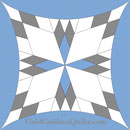 Chimney Swallows
Chimney Swallows Friendship Knot
Friendship Knot  Friendship Knot
Friendship Knot  Friendship Knot
Friendship Knot  Cleo-patra's
Cleo-patra's  Winding
Winding Greek Cross
Greek Cross







 Queen's Pride
Queen's Pride Queen's Pride
Queen's Pride


 Chimney Swallows
Chimney Swallows Chimney Swallow
Chimney Swallow 
 Chimney Swallows
Chimney Swallows  Chimney Swallows
Chimney Swallows

 Friendship Knot
Friendship Knot 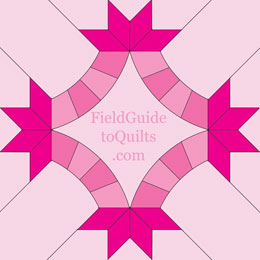 Friendship Knot
Friendship Knot 
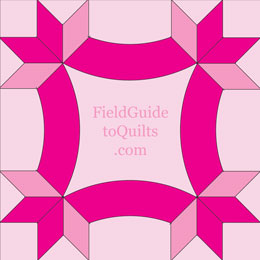 Friendship Knot
Friendship Knot

 Cleopatra's Fan
Cleopatra's Fan



 Winding Ways
Winding Ways
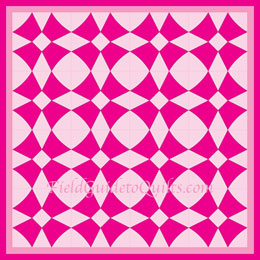
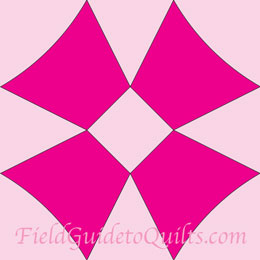 Greek Cross
Greek Cross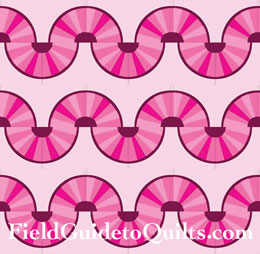
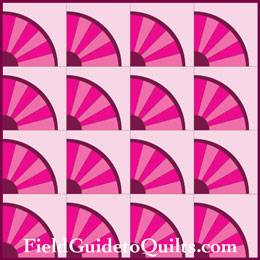
 Grandmother's Fan
Grandmother's Fan
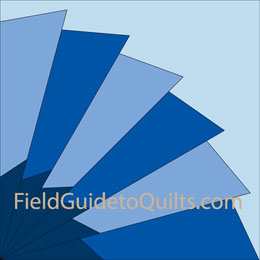 Milady's Fan
Milady's Fan




